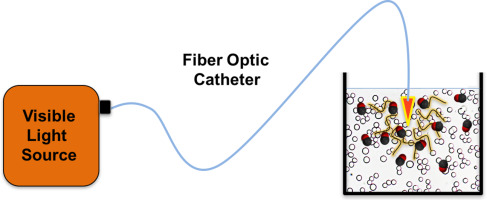Journal of Controlled Release ( IF 10.5 ) Pub Date : 2017-09-01 , DOI: 10.1016/j.jconrel.2017.08.039 Miguel N. Pinto , Indranil Chakraborty , Cosme Sandoval , Pradip K. Mascharak

|
The gaseous signaling molecule carbon monoxide (CO) has recently been recognized for its wide range of physiological activity as well as its antineoplastic properties. However, site-specific delivery of this noxious gas presents a major challenge in hospital settings. In this work, a visible light-sensitive CO-releasing molecule (photoCORM) derived from manganese(I) and 2-(quinolyl)benzothiazole (qbt) namely, [Mn(CO)3(qbt)(4-vpy)](CF3SO3) (1), has been co-polymerized within a gas-permeable HEMA/EGDMA hydrogel. The resulting photoactive CO-releasing polymer (photoCORP-1) incorporates 1 such that neither the carbonyl complex nor its photoproduct(s) exits the polymer at any time. The material can be triggered to photorelease CO remotely by low-power broadband visible light (< 1 mW cm− 2) with the aid of fiber optics technology. The CO photorelease rates of photoCORP-1 (determined by spectrophotometry) can be modulated by both the concentration of 1 in the hydrogel and the intensity of the light. A CO-delivery device has been assembled to deliver CO to a suspension of human colorectal adenocarcinoma cells (HT-29) under the control of visible light and the extent of CO-induced apoptotic death of the cancer cells has been determined via Annexin V/Propidium iodide stain and flow cytometry. This photoactive CO-releasing polymer could find use in delivering controlled doses of CO to cellular targets such as malignant tissues in remote parts of the body.











































 京公网安备 11010802027423号
京公网安备 11010802027423号